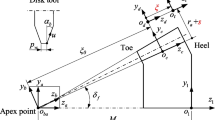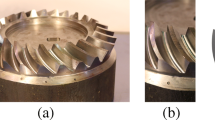Abstract
The whirl-machining process is a precise, efficient, and promising machine process for manufacturing workpieces over the milling process. At the same time, the roller-gear cam has advantages over the other cam-follower system. However, the whirl-machining process has not been applied to manufacture the roller-gear cam. Therefore, this paper proposes a novel method for roller-gear cam manufacturing using a whirl-machining process. Mathematical modeling is described for generating the roller-gear cam, roller, and whirl-milling tool surface. A novel CNC machine and its coordinate system are proposed. Cutting simulations for obtaining the surface topologies and normal deviations are conducted. Globoidal cam with different cylindrical rollers, globoidal cam with a conical roller, and cylindrical cam with a conical roller are taken as case studies, and results are discussed. A virtual cutting simulation was conducted using VERICUT. Some machining examples are shown to verify the benefits of the proposed method in roller-gear cam manufacturing.






















Similar content being viewed by others
Data availability
All data generated or analyzed during this study are included in the manuscript.
Code availability
Not applicable.
References
Wang L, He Y, Wang Y, Li Y, Liu C, Wang S, Wang Y (2020) Analytical modeling of material removal mechanism in dry whirling milling process considering geometry, kinematics and mechanics. Int J Mech Sci 172:105419. https://doi.org/10.1016/j.ijmecsci.2020.105419
Song SQ, Zuo DW (2014) Modelling and simulation of whirling process based on equivalent cutting volume. Simul Model Pract Theory 42:98–106. https://doi.org/10.1016/j.simpat.2013.12.011
He Y, Wang L, Wang Y, Li Y, Wang S, Wang Y, Liu C, Hao C (2019) An analytical model for predicting specific cutting energy in whirling milling process. J Clean Prod 240:118181. https://doi.org/10.1016/j.jclepro.2019.118181
Mohan LV, Shunmugam MS (2007) Simulation of whirling process and tool profiling for machining of worms. J Mater Process Technol 185:191–197. https://doi.org/10.1016/j.jmatprotec.2006.03.115
Matsumura T, Serizawa M, Ogawa T, Sasaki M (2015) Surface dimple machining in whirling. J Manuf Syst 37:487–493. https://doi.org/10.1016/j.jmsy.2014.07.008
Soshi M, Rigolone F, Sheffield J, Yamazaki K (2018) Development of a directly-driven thread whirling unit with advanced tool materials for mass-production of implantable medical parts. CIRP Ann Manuf Technol 1:117–120. https://doi.org/10.1016/j.cirp.2018.03.016
Liu C, He Y, Li Y, Wang Y, Wang L, Wang S, Wang Y (2021) Predicting residual properties of ball screw raceway in whirling milling based on machine learning. Measurement 173:108605. https://doi.org/10.1016/j.measurement.2020.108605
Liu C, He Y, Wang Y, Li Y, Wang S, Wang L, Wang Y (2019) An investigation of surface topography and workpiece temperature in whirling milling machining. Int J Mech Sci 164:105182. https://doi.org/10.1016/j.ijmecsci.2019.105182
Wang Y, Yin C, Li L, Zha W, Pu X, Wang Y, Wang J, He Y (2020) Modeling and optimization of dynamic performances of large-scale lead screws whirl milling with multi-point variable constraints. J Mater Process Technol 276:116392. https://doi.org/10.1016/j.jmatprotec.2019.116392
He Y, Liu C, Wang Y, Li Y, Wang S, Wang L, Wang Y (2019) Analytical modeling of temperature distribution in lead-screw whirling milling considering the transient un-deformed chip geometry. Int J Mech Sci 157–158:619–632. https://doi.org/10.1016/j.ijmecsci.2019.05.008
Serizawa M, Suzuki M, Matsumura T (2015) Microthreading in whirling. Journal of Micro- and Nano-Manufacturing 3:041001–041011. https://doi.org/10.1115/1.4030704
HS Yan and HH Chen (1996) Geometry design of globoidal cams with generalized meshing turret-rollers. J Mech Design 118. https://doi.org/10.1115/1.2826876
DM Tsay, NJ Huang, and BJ Lin (1999) Geometric design of roller gear cam reducers. J Mech Design 121. https://doi.org/10.1115/1.2829420
PD Lin and MF Lee (1997) Applications of D-H notation in machining and on-line measurement of roller-gear cams on 5-axis machine tools. J Manuf Sci Eng 119. https://doi.org/10.1115/1.2831119
Chen SL, Hong SF (2008) Surface generation and fabrication of roller gear cam with spherical rollers. J Adv Mech Design, Syst Manuf 2:3. https://doi.org/10.1299/jamdsm.2.290
Yan HS, Chen HH (1994) Geometry design and machining of roller gear cams with cylindrical rollers. Mech Mach Theory 29:6. https://doi.org/10.1016/0094-114X(94)90079-5
Van TN, Pokorny P (2009) Modelling concave globoidal cam with indexing turret follower: a case study. Int J Comput Integr Manuf 22:10. https://doi.org/10.1080/09511920902943655
Lo JS, Tseng CH, Tsay CB (2001) A study on the bearing contact of roller gear cams. Comput Methods Appl Mech Engrg 190:4649–4662. https://doi.org/10.1016/S0045-7825(00)00337-6
Litvin FL, Fuentes A (2004) Gear geometry and applied theory, 2nd edn. Cambridge University Press, Cambridge, UK. https://doi.org/10.1017/CBO9780511547126
Yan HS, Chen HH (1995) Geometry design of roller gear cams with hyperboloid rollers. Mathl Comput Modelling 22(8):107–117. https://doi.org/10.1016/0895-7177(95)00160-4
Zhang Y, Ji S, Zhao J (2016) Study on the geometric characteristics of mating surfaces of globoidal cam mechanisms. Mech Mach Theory 100:44–62. https://doi.org/10.1016/j.mechmachtheory.2016.01.014
Zongyu C, Ce Z, Yuhu Y, Yuxin W (2001) A study on dynamics of roller gear cam system considering clearances. Mech Mach Theory 36:143–152. https://doi.org/10.1016/S0094-114X(00)00038-0
Wan M, Zhang WH, Dang JW, Yang Y (2010) A novel cutting force modelling method for cylindrical end mill. Appl Math Model 34:823–836. https://doi.org/10.1016/j.apm.2009.09.012
Whalley R, Abdul-Ameer AA, Ebrahimi M (2008) Machine tool modelling and profile following performance. Appl Math Model 32:2290–2311. https://doi.org/10.1016/j.apm.2007.07.017
Neagu C, Lupeanu M, Rennie A (2013) A new design concept for milling tools of spherical surfaces obtained by kinematic generation. Appl Math Model 37:6119–6134. https://doi.org/10.1016/j.apm.2012.12.017
Sekine T, Obikawa T (2015) Novel path interval formulas in 5-axis flat end milling. Appl Math Model 39:3459–3480. https://doi.org/10.1016/j.apm.2014.11.046
Sambhav K, Tandon P, Dhande SG (2011) A generic mathematical model of single point cutting tools in terms of grinding parameters. Appl Math Model 35:5143–5164. https://doi.org/10.1016/j.apm.2011.04.017
Jia K, Guo J, Zheng S, Hong J (2019) A general mathematical model for two-parameter generating machining of involute cylindrical gears. Appl Math Model 75:37–51. https://doi.org/10.1016/j.apm.2019.05.021
Wu YR, Hsu WH (2014) A general mathematical model for continuous generating machining of screw rotors with worm-shaped tools. Appl Math Model 38:28–37. https://doi.org/10.1016/j.apm.2013.05.056
Urbikaina G, Artetxe E, de Lacalle LNL (2017) Numerical simulation of milling forces with barrel-shaped tools considering runout and tool inclination angles. Appl Math Model 47:619–636. https://doi.org/10.1016/j.apm.2017.03.001
Radzevich SP (2007) A novel method for mathematical modeling of a form-cutting-tool of the optimum design. Appl Math Model 31:2639–2654. https://doi.org/10.1016/j.apm.2006.10.014
Chen F, Hu S, Yin S (2012) A novel mathematical model for grinding ball-end milling cutter with equal rake and clearance angle. Int J Adv Manuf Technol 63:109–116. https://doi.org/10.1007/s00170-011-3889-y
Khan MR, Tandon P (2011) Mathematical modeling for the design of a generic custom-engineered form mill. Int J Adv Manuf Technol 54:139–148. https://doi.org/10.1007/s00170-010-2936-4
Pálmai Z, Csobod L (2017) The mathematical modelling of the impact of electric (Seebeck) effects on end-milling. Int J Adv Manuf Technol 88:115–126. https://doi.org/10.1007/s00170-016-8696-z
Ming X, Gao Q, Yan H, Liu J, Liao C (2017) Mathematical modeling and machining parameter optimization for the surface roughness of face gear grinding. Int J Adv Manuf Technol 90:2453–2460. https://doi.org/10.1007/s00170-016-9576-2
Jing X, Song B, Xu J, Zhang D (2022) Mathematical modeling and experimental verification of surface roughness in micro-end-milling. Int J Adv Manuf Technol 120:7627–7637. https://doi.org/10.1007/s00170-022-09244-7
Andrianto M, Wu YR, Arifin A (2022) A novel manufacturing method for double-enveloping worms using a whirl-machining process. Mech Machine Theory 179:105099. https://doi.org/10.1016/j.mechmachtheory.2022.105099
Bo P, González H, Calleja A, Norberto L, Lacalle LNL, Barton M (2020) 5-axis double-flank CNC machining of spiral bevel gears via custom-shaped milling tools Part I: Modeling and simulation. Precis Eng 62:204–212. https://doi.org/10.1016/j.precisioneng.2019.11.015
Calleja A, Bo P, Gonzalez H, Barton M, Lacalle LNL (2018) Highly accurate 5-axis flank CNC machining with conical tools. Int J Adv Manuf Technol 97:1605–1615. https://doi.org/10.1007/s00170-018-2033-7
Escudero GG, Bo P, Gonzalez-Barrio H, Calleja-Ochoa A, Barton M, Luis Norberto LNL, Lacalle (2022) 5-axis double-flank CNC machining of spiral bevel gears via custom-shaped tools—part II: physical validations and experiments. Int J Adv Manuf Technol 119:1647–1658. https://doi.org/10.1007/s00170-021-08166-0
Funding
This research was supported by the Ministry of Science and Technology in Taiwan, project number MOST 109–2221-E-008–004-MY2.
Author information
Authors and Affiliations
Contributions
Moeso Andrianto constructed the research design, accomplished the analytical simulation, conducted the virtual simulation, and composed the manuscript. Yu-Ren Wu earned the funding and directed the research implementation, whereas Achmad Arifin supervised the analytical and virtual simulation. All the authors worked concurrently to proofread and structure the submission.
Corresponding author
Ethics declarations
Ethics approval
Ethical standards are in place (no human participants or animals involved).
Consent to participate
Not applicable.
Consent for publication
All the involved authors have read and consented to publish the manuscript.
Competing interests
The authors declare no competing interests.
Additional information
Publisher's note
Springer Nature remains neutral with regard to jurisdictional claims in published maps and institutional affiliations.
Rights and permissions
Springer Nature or its licensor (e.g. a society or other partner) holds exclusive rights to this article under a publishing agreement with the author(s) or other rightsholder(s); author self-archiving of the accepted manuscript version of this article is solely governed by the terms of such publishing agreement and applicable law.
About this article
Cite this article
Andrianto, M., Wu, YR. & Arifin, A. Mathematical modeling on a novel manufacturing method for roller-gear cams using a whirl-machining process. Int J Adv Manuf Technol 125, 5015–5029 (2023). https://doi.org/10.1007/s00170-023-10990-5
Received:
Accepted:
Published:
Issue Date:
DOI: https://doi.org/10.1007/s00170-023-10990-5




